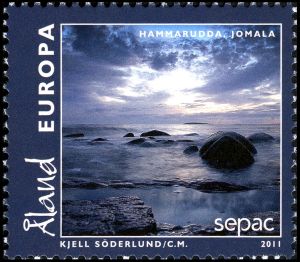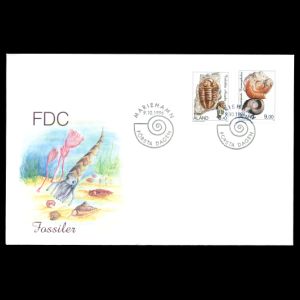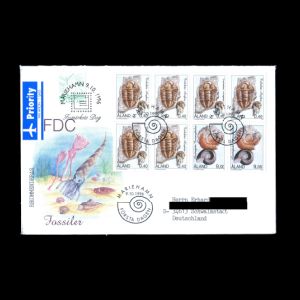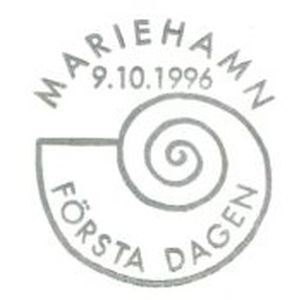Aland 1996 "Fossils"
| <prev | back to index | next> |
| Issue Date | 09.10.1996 |
| ID | Michel: 117-118; Scott: 85, 106; Stanley Gibbons: 113-114; Yvert: 118-119; Category: pF |
| Designer | Anna-Maaret Pitknen-Darmark |
| Stamps in set | 2 |
| Value | MK 0,40- Trilobite Asaphus MK 9,00- Gastropode Euomophalus should be spelled Euomphalus. |
| Emission/Type | Definitive. Valid until 30 June 2002. |
| Issue place | Mariehamn |
| Size (width x height) | 25mm x 45mm |
| Layout | Two Sheets 20 stamp each (4x5) |
| Products | FDC x 1 |
| Paper | |
| Gum type | Mint |
| Perforation | 14,75 |
| Print Technique | Offset, multicolor |
| Printed by | The House of Questa |
| Quantity |
Trilobite stamp: 800.000 Gastropode stamp: 600.000 |
| Issuing Authority | Aland Posten |

On October 9th, 1996 Post Authority of Aland - Aland Posten - issued a set of 2 definitive stamps, showing some fossils found on the islands.
On the Aland islands between Sweden and Finland in the Baltic sea, you can find fossils from the Ordovician period. This is the only place in Finland where you can find fossils. These fossils can be seen in University Museum in Helsinki. East of the main island there is a 9 kilometre diameter crater (Lumparn). This crater was formed by a meteor or comet impact 1200 to 500 million years ago. It is possible to go to the Finnish Aland Islands by ferry from the Swedish or the Finnish mainland.

|
| Jomala Island, the best place to look for fossils at Aland, on stamp of Aland 2011, MiNr.: 351, Scott: 323 |
The Aland Islands form an archipelago in the Baltic Sea. They are situated at the entrance to the Gulf of Bothnia and form an autonomous, demilitarised, monolingual Swedish-speaking region of Finland. The first Aland stamps were issued 1 March 1984. Approximately 15 stamps describing the Aland nature, culture, history, society and autonomy are issued every year. Stamps of Aland can be used both for internal and international post services.
The stamps depict two fossils, a gastropod, Eumophalus, and a trilobite Asaphus.
 |
| Asaphus, Ordovician Trilobites on stamps of Aland 1996, MiNr.: 117, Scott: 85. |
Trilobites (meaning "three lobes") are a well-known fossil group of extinct marine arthropods in the class Trilobita.
The first appearance of trilobites in the fossil record defines the base of the Atdabanian stage of the Early Cambrian period (521 million years ago), and they flourished throughout the lower Paleozoic era before beginning a drawn-out decline to extinction when, during the Devonian, all trilobite orders except Proetida died out. Trilobites finally disappeared in the mass extinction at the end of the Permian about 250 million years ago. The trilobites were among the most successful of all early animals, roaming the oceans for over 270 million years.
Trilobites had many lifestyles; some moved over the sea-bed as predators, scavengers or filter feeders and some swam, feeding on plankton.

|
| Euomphalus, marine gastropoda on stamp of Aland 1996, MiNr.: 118, Scott: 106. |
Euomphalus is a genus of fossil marine gastropods known to have lived from the Silurian to the Middle Permian.
The Gastropoda or gastropods, more commonly known as snails and slugs, are a large taxonomic class within the phylum Mollusca. The class Gastropoda includes snails and slugs of all kinds and all sizes from microscopic to large. There are many thousands of species of sea snails and sea slugs, as well as freshwater snails, freshwater limpets, land snails and land slugs.
Euomphalus is characterized by a closely coiled shell with a depressed to slightly elevated spire and a channel-bearing angulation (a selenizone) on the upper surface of the whorls. The lower surface of the whorls is rounded to angular.
Products and associated philatelic items
| Mini-Sheets | "Gutter Pairs" | CTO stamps |
 |
 |
 |
| Several Mini-Sheets of the same stamps were printed in one big sheet, then cut into "gutter pairs". | ||
| FDC (clean and posted from Aland to Germany) | First-Day-of-Issue Postmark | |
 |
 |
 |
| The reverse side is here | The reverse side is here | |

|
- Technical details: Colnect, Stamp Catalogue 1984-2017 of Aland Post AB (page 17), StampedOut.
- Fossils of Aland: Fossil.net, the Fossil Forum.
- University Museum in Helsinki: official site, Wikipedia
- Asaphus: Wikipedia
- Euomphalus: Wikipedia.
Acknowledgements:
- Many thanks to Dr. Peter Voice from Department of Geological and Environmental Sciences, Western Michigan University, for the draft page review.
- Many thanks to "From My Philately" community of Facebook, for help finding information about these stamps.
| <prev | back to index | next> |